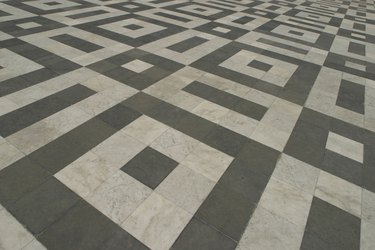
Karndean flooring was developed in the United Kingdom in 1973 and is currently available in the United States through retail flooring outlets. Their vinyl-based flooring with recycled PVC comes in several patterns that mimic natural materials such as wood, slate, marble, and glass. Karndean adhesives present the same problems as other vinyl adhesives upon removal of the floor covering.
Vinyl Over a Wood Subfloor
Video of the Day
Wood absorbs the adhesive glue, creating a seal that helps prevent water damage. It also prevents easy removal and replacement of the flooring. Pulling up the vinyl flooring in strips usually leaves a great deal of adhesive on the floor. Removing the leftover adhesive requires scraping the floor until it is clean. A heat gun can melt the adhesive until it is soft, which helps lessen the force needed to remove it, but it creates an issue of stickiness which can make it even messier.
Video of the Day
Solvents
Sometimes even the strongest elbow grease cannot remove all of the adhesive from a subfloor. Solvent is one answer, but solvents come with problems of their own. Water-based solvents are not always effective on hard-to-remove adhesives. Chemical-based solvents work better, but are more toxic, require more ventilation than water-based solvents, and generally smell unpleasant. Both types of solvents liquefy the adhesive and will cause it to become sticky.
Stickiness and Dust
The sticky residue remaining after using solvents or a heat gun is difficult to remove from clothing and carpeting. Cover any adjacent carpeting to prevent contact. Use heavy-duty rags to clean the floor, then place the rags in a plastic container with a tight-fitting lid, to prevent accidental spillage. If you are sanding and/or scraping the adhesive, ensure adequate ventilation. Wear a mask in either case to prevent inhalation of irritating or toxic fumes and particles.
When the Adhesive is Black
After removing the flooring you may find the adhesive used is black. This indicates the use of "cutback" adhesive, an asphalt-based glue that was used with asbestos tiles and many times contained asbestos itself. Asbestos causes cancer and respiratory diseases. Removal of asbestos products is regulated at the federal, state, and often times local levels. If you find "cutback" adhesive under your flooring, contact a flooring professional. Many times the resolution is to actually seal the adhesive residue in place, lay another subflooring and place the new flooring on top of it.
- Karndean International: "Our Flooring Company"
- Improvenet.com: "Advise from Other Experts:Removing Linoleum of Vinyl Flooring and Glue": Jeff Williams
- Vinyl Flooring Desing Ideas and Tips: "Vinyl Flooring Adhesive Removal-What to Know to Make Things Easier"
- Floor Covering Installer: "FCICA: Installing Resilient Flooring over Cutback Adhesive":Christopher Capobianco: 2006
- Armstrong Floor Expert Database: "Removal of Resilient Floor Tile, Sheet Flooring, and Cutback Adhesive"